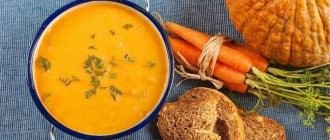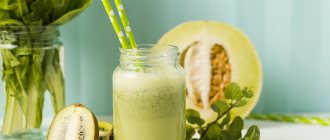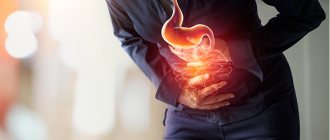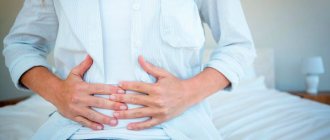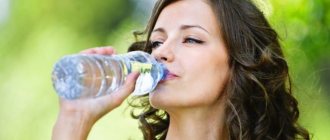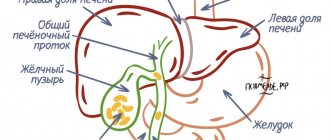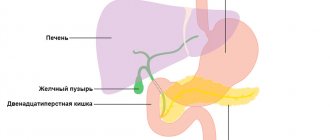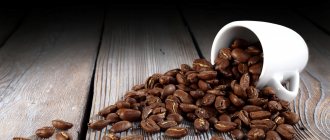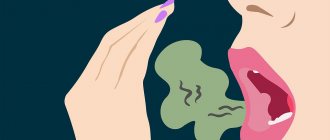- What does a diet do for cholecystitis?
- Diet therapy for acute cholecystitis
- Principles of diet for chronic cholecystitis
- What not to eat: prohibited foods
- What is allowed to be eaten?
- Sample menu for chronic cholecystitis
Diet therapy is the basis for the treatment and prevention of exacerbations in most diseases of the digestive tract. For people with cholecystitis, a well-designed diet becomes the basis for treatment and prevention of recurrent exacerbations. At the same time, the restrictions apply to both the composition of the food basket and the method of heat treatment, and the severity of the diet depends on the stage of the inflammatory process and the form of the disease.
Features of nutrition after cholecystectomy
When drawing up a diet after removal of the gallbladder, the aspect of gradually expanding the volume of food intake is taken into account.
After the operation, the body’s production of bile continues at the same level for the first time. This amount is not enough for complete digestion. The patient is recommended to undergo several stages of therapeutic nutrition at once, allowing the body to gradually rebuild the function of bile secretion by expanding the ducts.
Important! The patient fasts for the first 24 hours after laparoscopy. From 2 to 4 days, dietary food No. 0a is prescribed, a week later - surgical diet No. 1. It is recommended for the patient to adhere to diet No. 5 after the first week of the postoperative period.
In the first days you cannot eat or drink anything. If the patient is thirsty, you can moisten your lips with cotton wool and wipe your forehead with a wet towel. Next, the patient should eat according to diet No. 0a - light meals of liquid or semi-liquid consistency.
Diet No. 0a
- you can drink still water, a decoction of rose hips or jelly with dried fruits;
- eat only unsweetened fruit jellies with natural juice (pumpkin, beets, apples);
- Between meals, drink 1% kefir or weak green tea.
In the postoperative diet, proper nutrition is of great importance - food should be at room temperature, finely crushed, it is recommended to eat 200 grams of food regularly. Eat 5-6 times a day, intervals between meals up to 3 hours.
Frequent meals prevent stagnation of bile in the stomach. And the frequency of meals according to the schedule normalizes the synthesis of bile, and will enable the body to correct the possibility of enzyme formation in the ducts.
On the 5th day after surgical treatment, porridge, lean meat, fish and dairy products are added to the patient’s diet.
Diet No. 1
Table No. 1 includes vegetable broths with rice or noodles, which can be seasoned with cream or boiled egg. It is possible to diversify the menu with fish or lean meats.
Sample menu for one day for diet No. 1:
- 7.00 – liquid oatmeal, steam omelette, unsweetened green tea;
- 10.00 – low-fat kefir;
- 13.00 – semolina soup, chicken soufflé, compote with dried fruits;
- 16.00 – fish soufflé, slimy rice porridge;
- 19.00 – boiled beef, tea.
Diet No. 1 allows you to drink up to one liter of still water per day.
Diet No. 5
Diet No. 5 involves the introduction of boiled, baked or stewed foods at room temperature with a low carbohydrate content into the patient’s diet. Refractory fats are excluded from the diet, and protein products remain at the same level of consumption.
Sample daily menu No. 5 for cholecystectomy:
- steamed omelette, buckwheat porridge, green tea;
- cottage cheese 5%, rosehip tea;
- oatmeal, pureed beef;
- baked apple;
- pumpkin puree, crushed white fish;
- jelly from dried fruits or berries.
The duration of diet No. 5 is established by the doctor based on dynamic observations of the patient and analysis of clinical data of the postoperative period. If there are no contraindications to switching to a common table, you can gradually introduce non-rich liquid first courses, as well as steamed cutlets.
Important! If there are contraindications or unstable dynamics, the patient is recommended to continue following diet No. 5.
Principles of diet for chronic cholecystitis
A diet for cholecystitis without exacerbation is a balanced, fairly varied, complete menu in composition and calorie content. It corresponds to treatment table No. 5 according to Pevzner.
The food you eat should not overstimulate the gallbladder and increase the risk of stones forming in it, which can lead to an attack of biliary colic. Therefore, a person after suffering acute cholecystitis or with newly diagnosed latent (asymptomatic) chronic cholecystitis will have to reconsider his diet.
Some foods and methods of preparing them will have to be abandoned, and these restrictions should not be short-term. A diet for chronic cholecystitis is actually a way of life, a healthy and preventive daily diet. Of course, it has its own characteristics:
- Meals for cholecystitis should be divided, 3 main meals and 2-3 snacks are recommended. This regimen will allow you to avoid overeating and “hungry” periods, which will ensure uniform load on the gallbladder.
- It is advisable to eat at approximately the same hours. This will contribute to the timely appearance of appetite and the natural preparation of the digestive tract and gall bladder for the intake of nutrients.
- The menu should include all essential nutrients (proteins, fats and carbohydrates), vitamins and minerals. The total caloric content of the diet and the balance of substances are compiled taking into account age, gender and physical activity. In this case, fats must be distributed fairly evenly between all meals.
- Prohibited foods are completely excluded from the diet, even in the absence of exacerbations for a long time. Some foods are consumed in limited quantities, and if discomfort occurs after eating, it is advisable to avoid them. Errors in nutrition during cholecystitis are fraught with overload of the gallbladder with the development of biliary colic or activation of the inflammatory process.
- Food can be prepared by steaming, boiling, baking (without forming a crust). Frying and marinating are strictly prohibited. Stewing is also undesirable in case of frequent exacerbations, because with this method of cooking quite a lot of extractive substances are formed.
- Overeating should be avoided, both in terms of calories and portion size.
- It is necessary to drink enough water to avoid thickening of body fluids (including bile).
In case of chronic cholecystitis, nutrition does not imply fasting and consuming a small range of foods. These are rather reasonable dietary restrictions while maintaining nutritional value and sufficient dietary diversity. In general, the diet for cholecystitis is approximately the same as for pancreatitis.
What can you eat after gallbladder removal?
The selection of products for table No. 5 is based on normalizing excess body weight and balancing lipid metabolism. This is the most gentle nutrition for those who have undergone cholecystectomy. In order not to provoke complications of postcholecystectomy syndrome (duodenitis, gastritis, pancreatitis), the patient is recommended to adhere to the diet for life.
Products allowed for consumption during the postcholecystic period:
- Dried bread made yesterday.
- Unleavened cookies.
- Vegetable soups, pasta, cereals.
- Dietary dishes made from chicken and beef.
- Milk sausages.
- Dishes with crushed lean fish (cod fillet, pike perch, pike, hake).
- Porridge of semi-viscous consistency made from oatmeal or buckwheat.
- Fresh fruits - pears, bananas, cherries, raspberries, strawberries, watermelons, sweet apricots and baked apples.
- Low-fat fermented milk products.
- One egg a day.
- 50 grams of vegetable or butter per day.
To prevent stagnation of bile in the stomach, you need to drink a decoction of rose hips.
When following a diet, constipation may occur periodically. To prevent intestinal upset, adjust your diet by adding vegetable salads or kefir.
How to choose ripe persimmons
In order for eating this berry to bring only pleasure, you should choose it correctly. Despite the fact that unripe persimmons may have an excellent presentation, you should not buy them, because they may turn out to be inedible due to their incredible astringency.
A berry that was picked unripe will be hard to the touch and its color will be yellowish-orange. Only Sharon persimmon can have a dense and elastic consistency without being tart. You should try to buy berries of all other varieties fully ripe. Ripe persimmons are dark orange in color and will feel soft to the touch.
What should you not eat after gallbladder removal?
Prohibited products include:
- fresh bread, baked goods;
- alcoholic drinks;
- fat meat;
- mushrooms;
- canned foods (vegetables, canned fish);
- smoked meats;
- hot spices;
- caffeine.
If the gallbladder has been removed, you should not eat fried, sour foods and sweets (chocolate, cream products, candies).
Fully or partially limited products
Mushroom, meat and fish broths, green cabbage soup, and okroshka are completely excluded from the menu; solid animal fats (cooking fats, pork, lamb lard), fatty pork, goose meat, duck meat, offal (brains, liver, kidneys), most sausages, smoked meats, canned food, fresh bread, dough (butter, puff pastry), fried pies, fried and hard-boiled chicken eggs, smoked, salted and fatty fish, canned fish, full-fat cottage cheese, cream, whole milk 6% fat, sour cream, salted cheese, seasonings (pepper, mustard, horseradish) and sauces.
Irritating gastrointestinal tract and difficult-to-digest products of plant origin are limited: all types of legumes (peas, beans, chickpeas, soybeans), mushrooms, sorrel, radishes, spinach, radishes, green onions, garlic, pickled and canned vegetables. You cannot include spicy and fatty snacks, various caviar, as well as ice cream, chocolate, confectionery, cocoa, carbonated and alcohol-containing drinks, black coffee, sour berries, fruits, and juices from these products in your diet.
Table of prohibited products
| Proteins, g | Fats, g | Carbohydrates, g | Calories, kcal | |
Vegetables and greens | ||||
| canned vegetables | 1,5 | 0,2 | 5,5 | 30 |
| peas | 6,0 | 0,0 | 9,0 | 60 |
| chickpeas | 19,0 | 6,0 | 61,0 | 364 |
| beans | 7,8 | 0,5 | 21,5 | 123 |
| spinach | 2,9 | 0,3 | 2,0 | 22 |
| sorrel | 1,5 | 0,3 | 2,9 | 19 |
Berries | ||||
| grape | 0,6 | 0,2 | 16,8 | 65 |
Snacks | ||||
| potato chips | 5,5 | 30,0 | 53,0 | 520 |
Flour and pasta | ||||
| vareniki | 7,6 | 2,3 | 18,7 | 155 |
Bakery products | ||||
| sliced loaf | 7,5 | 2,9 | 50,9 | 264 |
| buns | 7,9 | 9,4 | 55,5 | 339 |
Confectionery | ||||
| cookie | 7,5 | 11,8 | 74,9 | 417 |
Ice cream | ||||
| ice cream | 3,7 | 6,9 | 22,1 | 189 |
Chocolate | ||||
| chocolate | 5,4 | 35,3 | 56,5 | 544 |
Raw materials and seasonings | ||||
| mayonnaise | 2,4 | 67,0 | 3,9 | 627 |
Dairy | ||||
| milk 4.5% | 3,1 | 4,5 | 4,7 | 72 |
| cream 35% (fat) | 2,5 | 35,0 | 3,0 | 337 |
Cheeses and cottage cheese | ||||
| gouda cheese | 25,0 | 27,0 | 2,0 | 356 |
| parmesan cheese | 33,0 | 28,0 | 0,0 | 392 |
Meat products | ||||
| fatty pork | 11,4 | 49,3 | 0,0 | 489 |
| salo | 2,4 | 89,0 | 0,0 | 797 |
| bacon | 23,0 | 45,0 | 0,0 | 500 |
Sausages | ||||
| smoked sausage | 9,9 | 63,2 | 0,3 | 608 |
Bird | ||||
| duck | 16,5 | 61,2 | 0,0 | 346 |
| goose | 16,1 | 33,3 | 0,0 | 364 |
Fish and seafood | ||||
| salmon | 19,8 | 6,3 | 0,0 | 142 |
| salmon | 21,6 | 6,0 | — | 140 |
| trout | 19,2 | 2,1 | — | 97 |
Alcoholic drinks | ||||
| white dessert wine 16% | 0,5 | 0,0 | 16,0 | 153 |
| dry red wine | 0,2 | 0,0 | 0,3 | 68 |
| vodka | 0,0 | 0,0 | 0,1 | 235 |
| beer | 0,3 | 0,0 | 4,6 | 42 |
Non-alcoholic drinks | ||||
| soda water | 0,0 | 0,0 | 0,0 | — |
| cola | 0,0 | 0,0 | 10,4 | 42 |
| * data is per 100 g of product | ||||
Sample menu for the week
It will be difficult to follow such a diet for the first months. With a creative approach to preparation, diet food can be made tasty and healthy.
Weekly menu table
| Monday | 7.00 – cottage cheese casserole, tea 10.00 – steam cutlet, yesterday’s bread, dried fruit jelly 13.00 – one glass of kefir 0% 16.00 – fish stew with steamed vegetables, tea 19.00 – unsweetened cookies |
| Tuesday | 7.00 – fruit soufflé, fresh fruit 10.00 – buckwheat with vegetable broth, boiled egg, 100 gr. steamed beef, dried fruit jelly 13.00 – low-fat yogurt 16.00 – vegetable soup with milk sausage, tea 19.00 – yesterday’s bread |
| Wednesday | 7.00 – milk soup, berry compote 10.00 – vegetable stew with steamed chicken, bread, berry jelly 13.00 – one glass of juice 16.00 – baked fish, rosehip decoction 19.00 – fresh fruit |
| Thursday | 7.00 – cottage cheese soufflé, dried fruit compote 10.00 – potatoes with boiled chicken, bread, tea 13.00 – low-fat kefir 16.00 – cauliflower soup 19.00 – berry jelly |
| Friday | 7.00 – steamed egg omelet, tea 10.00 – steam cutlet with oatmeal, milk 13.00 – pearl barley porridge, sausage, baked apple 16.00 – vegetable casserole 19.00 – berry soufflé |
| Saturday | 7.00 – cabbage casserole with low-fat sour cream, rosehip infusion 10.00 – pasta with chicken, bread, jelly 13.00 – kefir 0% 16.00 – stew with vegetables and chicken, tea 19.00 – mineral water without gas |
| Sunday | 7.00 – rice with boiled duck, tea 10.00 – vegetable soup, berry soufflé 13.00 – Lenten borscht, tea 16.00 – boiled potatoes, sausage, boiled egg, yesterday’s bread, jelly 19.00 – unsweetened cookies |
To diversify the menu, you can independently create a list of dishes for the weekly menu.
How to make persimmons less tart
If you had to buy unripe fruits, you should not eat them right away. We need to let them ripen. To do this, place the berries along with ripe apples and bananas in a warm room. The gases released by these fruits will help break down the tannin and make the persimmon less tart.
Temperature can also remove the astringent taste from the berries. You can freeze persimmons for two days. It will become sweeter and less tart.
You can also place the fruits in warm (about +40°C) water for twelve hours. The astringent taste should go away.
The persimmon season, which began at the end of October, lasts until the end of winter. The fruits are consumed fresh, dried and dried, jam and jam are made from them, and wine is made. You can also freeze ripe fruits to prolong the pleasure of eating them longer.
Subject:
- Persimmon
Dish recipes
Dietary nutrition after cholecystectomy is an integral part of the rehabilitation of the postoperative period for the patient. The purpose of such a diet is to reduce the load on the digestive system of animal fats.
Cauliflower soup
Blanch the vegetable and divide into inflorescences. Cook the cabbage in lightly salted water for no more than 5 minutes. Grind with a blender, add the mixture to the vegetable broth. Add 1 tbsp to the puree. l. wheat flour. Cook the soup over low heat for another 5 minutes after boiling, stirring constantly with a spoon. Before serving, add a piece of butter to the bowl of soup.
Steam cutlets
You will need:
- 300 gr. chicken fillet;
- 1 onion;
- 1 carrot;
- zucchini
Boil meat and vegetables separately, chop finely and grind in a blender. Add a raw egg to the mixture. Form cutlets. The process of cooking a dish in a double boiler lasts at least half an hour. Serve with potato side dish.
Milk porridge with rice
Boil the rice and puree in a blender until it becomes a paste. Boil a glass of milk. Add rice, a little salt and butter. Boil the porridge over low heat for 5 minutes.
Rice jelly
Add starch and sugar to the rice water. Serve warm with bread crumbs or Lenten cookies.
Cottage cheese casserole from the oven
Necessary:
- 250 gr. low-fat cottage cheese;
- 1 chicken egg;
- 2 tbsp. l. semolina and sugar;
- oil for baking sheet.
Rub the cottage cheese through a sieve, combine the mixture with the rest of the ingredients, and beat with a mixer. Pour the mixture onto a greased baking sheet and bake at 180 degrees for 30 minutes. Serve with strawberry or raspberry jam.
After dietary nutrition, the body gets used to the dishes, and other organs begin to perform the functions of the gallbladder. With positive dynamics, the menu expands and new products are added. To achieve uniform variety, use different variations in preparation and combination of acceptable products.
Useful properties of persimmon
At the end of October, the season of an incredibly tasty berry - persimmon - begins. The ancient Greeks were fans of these orange fruits, who called them the food of the Gods. And this berry came to Europeans from China, conquering even such distant continents as America and Australia. The tart varieties are considered to be those that grow in the Caucasus, and the sweeter ones are Japanese and Chinese.
In addition to its exquisite, delicious taste, with dozens of different shades, the fruit has an incredible amount of substances beneficial to humans. First of all, it is a huge amount of beta-carotene. There is more of it in persimmons than in such recognized champions as carrots, tomatoes, pumpkin, and sweet red peppers.
The content of this substance in the fruit determines its antioxidant properties: prevention of oncology, long-term youth of epithelial cells. In addition, the prototype vitamin A has a beneficial effect on eye health.
The berry contains a huge amount of iron. There is more of it than in apples. Therefore, the fruit is successfully used to treat hemoglobin deficiency and anemia. Potassium salts and magnesium help support heart, lung and kidney health.
There is a lot in persimmon:
- copper;
- manganese;
- iodine;
- vitamins of group B, C, P, A.
These substances improve mood, strengthen the immune system, fight fatigue, and improve the functioning of the liver, brain and blood vessels.
Orange plum has bactericidal properties, which determines its use in the treatment and prevention of colds. In addition, she:
- reduces blood pressure;
- treats hemorrhoids;
- treats the thyroid gland;
- removes sand and stones from the kidneys;
- stabilizes the functioning of the intestines and stomach;
- serves as a prevention of stroke and heart attack.
